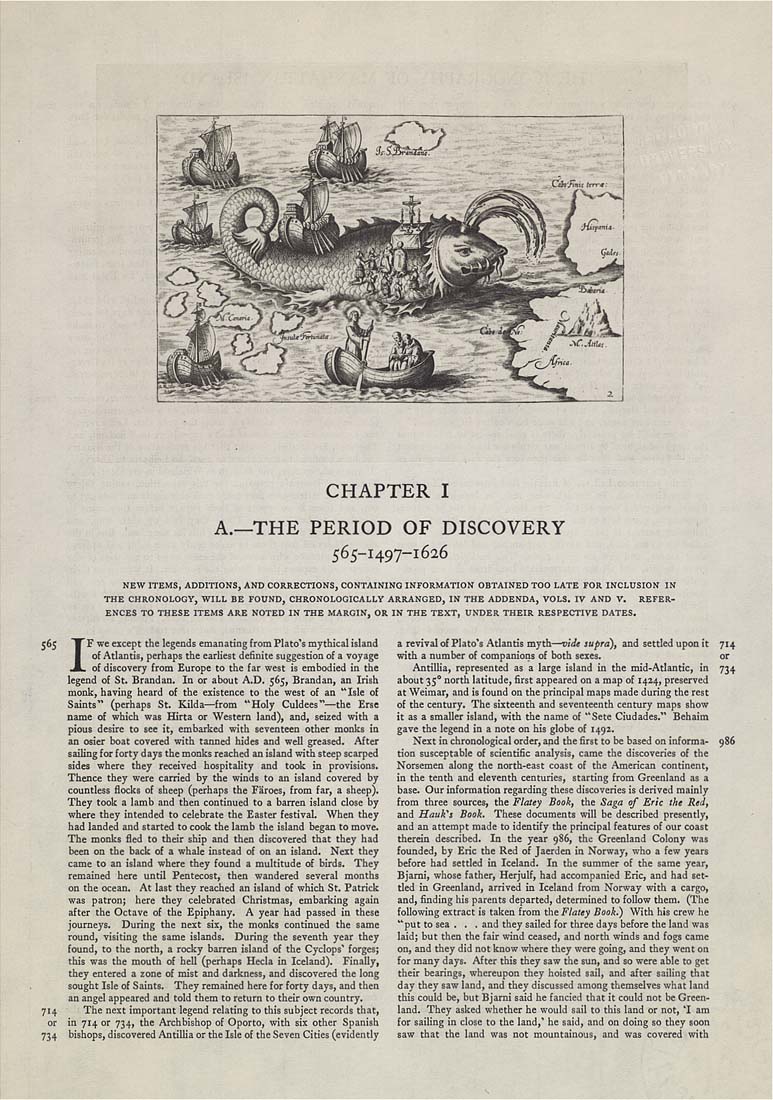CHAPTER I
A.—THE PERIOD OF DISCOVERY
565-1497-1626
NEW ITEMS, ADDITIONS, AND CORRECTIONS, CONTAINING INFORMATION OBTAINED TOO LATE FOR INCLUSION IN
THE CHRONOLOGY, WILL BE FOUND, CHRONOLOGICALLY ARRANGED, IN THE ADDENDA, VOLS. IV AND V. REFER¬
ENCES TO THESE ITEMS ARE NOTED IN THE MARGIN, OR IN THE TEXT, UNDER THEIR RESPECTIVE DATES.
J65 TF we ercept the legends emanating from Plato's mythical island
I oF Atlanlis, perhaps the earliest definite suggestion of a voyage
.A. of discovery from Europe to the far west is embodied in the
legend of St. Brandan, In or about A.D. 565, Brandan, an Irish
monk, having heard of the eiistence to the west of an "Isle of
Saints" (perhaps St. Kilda—from "Holy Culdees"—the Erse
name of which was Hirta or Western land), and, seiied with a
pious desire to see it, embarked with seventeen other monks in
an osier boat covered with tanned hides and we!l greased. After
sailing for forty days the monks reached an island with steep scarped
sides where they received hospitality and took in provisions.
Thence they were carried by the winds to an island covered by
countless flocks of sheep (perhaps the Faroes, from far, it sheep).
They took a Iamb and then continued to a barren island close by
where they intended to celebrate the Easter festival. When they
had landed and started to cook the lamb the island began to move.
The monks fled to their ship and then discovered that they had
been on the back oE a whale instead of on an island. Next they
came to an island where they found a multitude of birds. They
remained here until Pentecost, then wandered several months
on the ocean. At last they reached an island of which St. Patrick
was patron; here they celebrated Christmas, embarking again
after the Octave of the Epiphany. A year had passed in tliese
journeys. During the next six, the monks continued the same
round, visiting the same islands. During the seventh year they
found, to the north, a rocky barren island of the Cyclops' forges;
this was the mouth of bell (perhaps Hecla in Iceland). Finally,
they entered a zone of mist and darkness, and discovered the long
sought Isle of Saints. They remained here for forty days, and then
an angel appeared and told them to return to their own country.
714 The next important legend relating to this subject records that,
or in 714 or 734, the Archbishop of Oporto, with six other Spanish
7J4 bishops, discovered Antillia or the Isle of the Seven Cities (evidently
a revival of Plato's Atlantis myth—oiJt supra), and settled upon it 714
with a number of companions of both sexes. or
Anrillia, represented as a large island in the mid-Atlantic, in 734
about 35° north latitude, first appeared on a map of 1414, preserved
at Weimar, and is found on the principal maps made during the rest
of the century. The sixteenth and seventeenth century maps show
it as a smaller island, with the name of "Sete Ciudades." Bebaim
gave the legend in a note on his globe of 1491.
Next in chronological order, apd the first to be based on informa- 986
tion susceptable of scientific analysis, came the discoveries of the
Norsemen along the north-east coast of the American continent,
in the tenth and eleventh centuries, starting from Greenland as a
base. Our information regarding these discoveries is derived mainly
from three sources, the FJaiey Book, the Saga of Eric rhe Red,
and Hiiuk's Book. These documents will be described presently,
and an attempt made to identify the principal features of our coast
therein described. In the year 586, thi; Greenland Colony was
founded, by Eric the Red of Jaerden in Norway, who a few years
before had settled in Iceland. In the summer of the same year,
Bjami, whose father, Herjulf, had accompanied Eric, and had set¬
tled in Greenland, arrived in Iceland from Norway with a cargo,
and, finding his parents departed, determined to follow them. (I'he
following extract is taken from the Flaley Book.) With his crew he
"put to sea . . . and they sailed for three days before the land was
laid; but then the fair wind ceased, and north winds and fogs came
on, and they did not know where they were going, and they went on
for many days. After this they saw the sun, and so were able to get
their bearings, whereupon they hoisted sail, and after sailing that
day they saw land, and they discussed among themselves what land
this could be, but Bjami said he fancied that it could not be Green¬
land. They asked whether he would sail to this land or not, T am
for sailing in close to the land,' be said, and on doing so they soon
saw that the land was not mountainous, and was covered with
|








